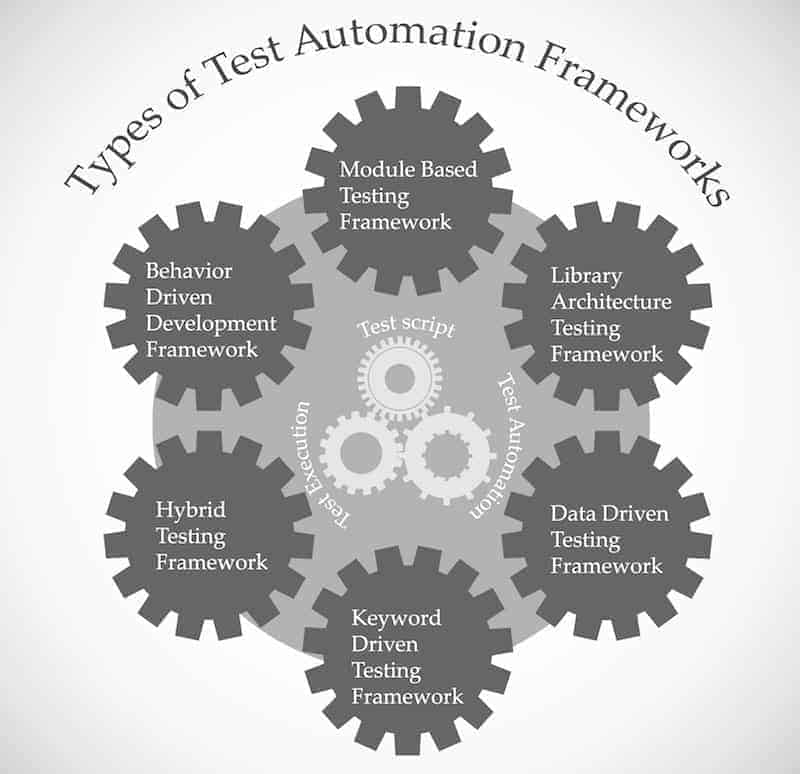Every business runs on software, and all software needs to be vetted before it is released to users. Beta testing and other crowd-sourcing methods have their uses, but they aren’t available for every step of the process.
Automated security testing is vital to developing good tools, resources, and products. For that, you need test automation frameworks.
Insufficiently tested software releases lead to unhappy customers. Conversely, comprehensive testing is expensive.
Frameworks supply resources and a streamlined process to test designers. This cuts labor costs, overall time investments in testing and other resources tied to deploying any software or computerized service. Much like a programming language saves programmers time by circumventing work in machine code, an automation framework helps testers by skipping some of the raw programming steps in the process.
In this article, we will discuss the types of frameworks and the benefits of each.

What is a Test Automation Framework?
A set of guidelines or standards that can help create quality assurance tests is commonly referred to as a test automation framework. The principle is that following a framework will improve the efficiency of both designing and executing automated tests that generate meaningful results.
These solutions provide the primary features of automated testing out of the box. Test platforms include a selection of features and the ability to script customized, repeatable tests. Often, automated testing solutions will work with existing technologies, APIs, and plug-ins, developing a robust feature set. This creates an environment through which testers can run and analyze their automated testing.
Types of Automation Testing Frameworks
The journey from knowing what a framework begins by understanding the different mainstream formats and their advantages and disadvantages.
Module Based Testing Framework
A modular automation framework breaks the overall test into smaller pieces. Each of those pieces is entirely independent of the others. This allows the test to assess different segments of the process in question to find areas of opportunity for improvement. The independent modular test results are then recombined for an overall quality assurance rating.
Modular testing has some definite advantages. The largest is the ability to reuse code. Each tested component might need to be assessed individually, but that does not require it to have unique scripts or parameters to run those tests. Any common actions among different modules can be operated with the same scripts. This saves time in both developing and performing the tests.
Conversely, modular testing comes with an inherent disadvantage. The framework is one that requires data sets to be embedded into the individual tests. If a function needs to be tested across a wide range of inputs, a modular framework will prove cumbersome.
Library Architecture Testing
Test automation framework design takes the concept of modular testing and tries to organize it more efficiently. Rather than testing the different components of the code in question, a library architecture framework groups similar functions. That enables a single module to test multiple interactions within the overall software and compare the results.
Library architecture might better be understood through an example. Consider a service that requires a user to log in. That action might appear at a number of different points within the service, so the library architecture finds and catalogs every such occurrence to test them with a single module. Interactions that require a user input variable data (such as financial statements for balancing a ledger) might be grouped in a different module.
This architecture adds layers of efficiency to traditional modular testing, but it still requires the same data embedding. In that, the library shares the fundamental weakness of modular frameworks.
Data-Driven Frameworks
A data-driven framework takes a substantially different approach to test design. The fundamental difference is that input data is stored separately from testing scripts. This eliminates the embedded-data issue that exists with modular frameworks. It also makes data-driven frameworks ideal for rapid-fire tests that simply rotate input data.
An additional advantage of this design philosophy is that it can simultaneously compare expectation values with actual test results. It can then tabulate that comparison across a range of parameters. This makes data-driven frameworks an obvious choice for tests that need such variable data, but there is a con. These tests require a higher understanding of the systems involved during the design stage. That can lead to non-trivial increases in test-design costs.
Keyword Driven Framework
Keyword-driven frameworks take the data-driven philosophy and run with it. In addition to storing data tables separately, they also save blocks of code on separate files. Entire scripts and more can be listed in external tables to be drawn as needed.
A keyword-driven framework streamlines test design. Since any given test function can be quickly identified and accessed by its keyword (hence the name), variable test scenarios can be mapped and executed in short order. Many keywords can be taken from open sources and grafted into the desired test. It’s a preferred methodology for testers who are not necessarily experts within the application field that is under scrutiny (e.g., a computer science specialist testing a fast food kiosk).
The drawback is that they can quickly complicate the testing system. An abundance of keywords can sometimes damage efficiency; this is an important trap to avoid.
Hybrid Testing
With the fundamental frameworks explained, it’s possible to cover hybrid frameworks using automated testing tools.
As the name implies, this includes any framework that combines any of the fundamental principles already covered. A keyword framework can potentially be used to rapidly build modular tests. Such a combination is ideal for anticipating user-friendliness and intuitive design. There is no real limit on how a hybrid automation framework can be combined. Real-world applications include hybridization more often than not.

Finding The Right Automated Testing Framework
By now it is clear that there is no single framework that is perfect for every test scenario.
The open-source frameworks listed above are also only a fraction of the total available. For their purpose, they are the best of the best, and if your test falls under their strengths, you are all set. They also cover the majority of mainstream testing needs. If you have an obscure niche, then additional research is necessary. Regardless, learning about test automation frameworks is only a single step in the journey.



